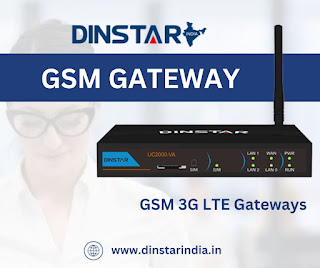GSM Gateways and FXO Gateways | Dinstar India | Call Now 9999284312
In today's interconnected world, efficient and cost-effective communication systems are essential for businesses. Two critical components that facilitate this are GSM Gateways and FXO Gateways. These devices play a crucial role in integrating traditional telephony with modern VoIP (Voice over Internet Protocol) systems, helping businesses streamline their communication infrastructure. This blog will provide an in-depth understanding of GSM Gateways and FXO Gateways, their functionalities, benefits, and practical applications.
What is a GSM Gateway?
A GSM Gateway, also known as a GSM VoIP Gateway, is a device that connects a VoIP system to the GSM network, allowing calls to be made and received over the GSM network. This device is particularly useful for businesses that need to manage large volumes of mobile calls.
Key Functions of a GSM Gateway
Call Routing: GSM Gateways route calls from VoIP to GSM networks and vice versa. This enables businesses to make mobile calls directly from their VoIP systems.
Cost Reduction: By using GSM Gateways, businesses can significantly reduce call costs, especially for international and mobile-to-mobile calls.
SMS Management: Many GSM Gateways also support sending and receiving SMS messages, integrating SMS capabilities into the VoIP system.
Failover Mechanism: In case of an internet or VoIP system failure, GSM Gateways can serve as a backup, ensuring continuous communication by routing calls through the GSM network.
Benefits of Using a GSM Gateway
Cost Savings: GSM Gateways can substantially lower the cost of mobile and long-distance calls by leveraging cheaper mobile network rates.
Flexibility: They offer flexibility by enabling seamless integration with existing VoIP systems, allowing businesses to manage all communication through a unified platform.
Scalability: Businesses can easily scale their communication infrastructure by adding more GSM channels as needed.
What is an FXO Gateway?
An FXO (Foreign Exchange Office) Gateway is a device that connects a VoIP system to the Public Switched Telephone Network (PSTN) through standard analog telephone lines. This device is essential for businesses that need to maintain a connection with traditional phone lines while transitioning to VoIP.
Key Functions of an FXO Gateway
Signal Conversion: FXO Gateways convert analog signals from the PSTN into digital VoIP signals, enabling seamless communication between traditional and VoIP systems.
Call Routing: They manage the routing of calls between the PSTN and the VoIP network, ensuring calls are directed to the correct destination.
Fax Support: Many FXO Gateways support fax transmissions, allowing businesses to send and receive faxes through their VoIP systems.
Failover Mechanism: In case of an internet or VoIP system failure, FXO Gateways can reroute calls through the PSTN, ensuring uninterrupted communication.
Benefits of Using an FXO Gateway
Seamless Integration: FXO Gateways enable businesses to integrate their existing analog phone lines with modern VoIP systems, ensuring a smooth transition to IP-based communication.
Cost Efficiency: By routing calls through the PSTN when necessary, businesses can optimize call costs, especially for local calls.
Flexibility: They offer flexibility by allowing businesses to maintain their existing analog phone lines while taking advantage of VoIP features.
Practical Applications of GSM and FXO Gateways
Use Cases for GSM Gateways
Small to Medium Businesses: Small and medium-sized businesses can use GSM Gateways to manage mobile communications cost-effectively, particularly for making international and long-distance mobile calls.
Call Centers: Call centers handling large volumes of outbound calls can benefit from GSM Gateways by reducing mobile call costs and improving call routing efficiency.
Remote Workforces: Businesses with remote or mobile employees can leverage GSM Gateways to ensure reliable and cost-effective communication.
Use Cases for FXO Gateways
Enterprises: Large enterprises transitioning from traditional telephony to VoIP can use FXO Gateways to integrate their existing analog lines with new VoIP systems, ensuring a smooth migration.
Healthcare Providers: Hospitals and clinics can use FXO Gateways to maintain reliable communication channels for critical services, ensuring they can fall back on PSTN in case of VoIP system failures.
Educational Institutions: Schools and universities can integrate their analog phone systems with VoIP using FXO Gateways, facilitating better communication and cost savings.
Choosing the Right Gateway for Your Business
When selecting a GSM or FXO Gateway for your business, consider the following factors:
Compatibility: Ensure the gateway is compatible with your existing telephony and VoIP systems. Check for support of necessary protocols like SIP .
Scalability: Choose a gateway that can scale with your business. Consider the number of channels you need now and in the future.
Quality: Look for gateways that offer high voice quality and support advanced features like call compression and echo cancellation.
Conclusion
GSM Gateways and FXO Gateways are essential tools for modern businesses looking to optimize their communication systems. GSM Gateways enable cost-effective mobile communication by bridging VoIP systems with GSM networks, while FXO Gateways facilitate the integration of traditional PSTN lines with VoIP systems. Both gateways offer numerous benefits, including cost savings, flexibility, scalability, and Investing in the right gateway solutions can significantly enhance your business's communication capabilities, ensuring you stay connected and competitive in today's fast-paced digital world.



Comments
Post a Comment